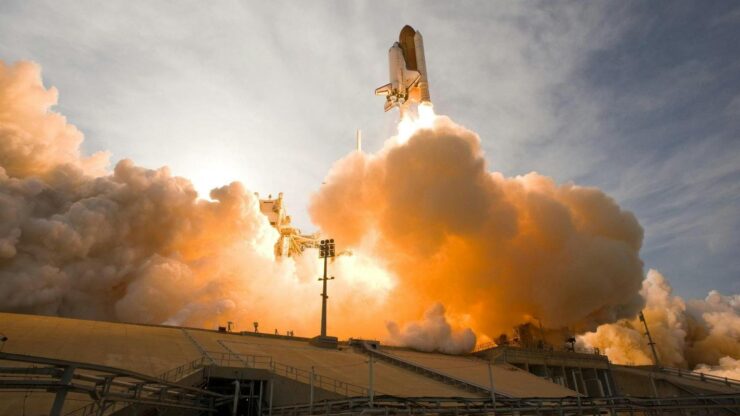Why Do Rockets Need to Travel at 25,000 mph to Escape Earth?
Published by GadgetNewz
Have you ever wondered how rockets fly into space? It’s not easy! Rockets need to go really, really fast to break free from Earth’s gravity. In fact, they must travel at 25,000 miles per hour (mph)—which is called escape velocity. But why do they need to go so fast? Let’s find out!
What is Escape Velocity?
Escape velocity is the speed a rocket needs to break free from Earth’s pull. Imagine throwing a ball up in the air—it always falls back down, right? That’s because of gravity. If you throw it faster, it goes higher, but it still comes back. Now, if you could throw the ball at 25,000 mph, it would keep going and never come back!

Why Do Rockets Need to Go So Fast?
- Earth’s Gravity is Strong – Our planet pulls everything down, so a rocket must go super fast to escape its grip.
- Air Slows Things Down – The air around Earth (our atmosphere) creates resistance. A rocket must push through it quickly to reach space.
- Save Fuel – Rockets don’t carry endless fuel. They must reach space as fast as possible to avoid running out.
Do All Rockets Need to Go This Fast?
Not always! Some rockets, like the ones that take astronauts to the International Space Station (ISS), only need to go 17,500 mph to stay in orbit. But if we want to go to the Moon, Mars, or farther, the rocket must reach 25,000 mph to escape Earth completely.
The Future of Space Travel
Scientists are working on new ways to travel into space more easily. Ideas like space elevators and ion thrusters might help in the future. But for now, rockets still need to go super fast to leave Earth!
FAQ: Why Does a Rocket Have to Go at 25,000 mph to Escape Earth?
1. What is escape velocity?
Escape velocity is the minimum speed a rocket must reach to break free from Earth’s gravitational pull without needing additional propulsion. For Earth, this speed is approximately 25,000 miles per hour (40,270 kilometers per hour) at the surface.
2. Why does a rocket need to travel at 25,000 mph to escape Earth?
A rocket needs to travel at this speed to overcome Earth’s gravity, which continuously pulls it back towards the planet. The 25,000 mph velocity ensures that the rocket has enough kinetic energy to break free from Earth’s gravitational influence and enter orbit or travel into space.
3. Does the rocket travel at 25,000 mph from the start?
Not immediately. Rockets initially accelerate slower, gradually increasing their speed as they ascend. The 25,000 mph figure represents the speed needed at a specific point, typically after the rocket has ascended through the atmosphere, as it reaches space.
4. Is escape velocity the same for all planets?
No, escape velocity depends on the mass and radius of the planet or celestial body. For example, escape velocity on the Moon is much lower (about 5,300 mph) because it has less mass and a smaller radius compared to Earth.
5. What happens if the rocket doesn’t reach 25,000 mph?
If the rocket doesn’t reach the escape velocity, it will not break free from Earth’s gravity. Instead, it may fall back to Earth or enter a lower orbit if it’s traveling at a speed insufficient to escape.
6. Is 25,000 mph a constant speed throughout the rocket’s journey?
No, the rocket’s speed changes during its journey. It accelerates during launch and stages of the flight, and it might not maintain 25,000 mph the entire time. The speed required to escape Earth is a dynamic calculation, factoring in altitude and other conditions.
7. Why is it so difficult to reach 25,000 mph?
Achieving 25,000 mph requires immense energy. The rocket must fight Earth’s gravity, atmospheric resistance, and other factors. It requires powerful engines, precise fuel management, and efficient engineering to reach such high speeds.
8. How do rockets achieve escape velocity if they don’t reach 25,000 mph immediately?
Rockets use multi-stage propulsion systems. Each stage accelerates the rocket further into space, shedding weight as it goes, which allows the remaining stages to continue accelerating. This gradual build-up helps the rocket eventually reach the necessary velocity to escape Earth’s gravity.
9. Can humans survive traveling at 25,000 mph?
Yes, astronauts can survive these speeds in spacecraft designed to withstand the forces involved. However, the acceleration forces are carefully managed through controlled launches, and the spacecraft is built to ensure safety during the journey.
10. Is 25,000 mph the same for all missions to space?
While the escape velocity from Earth remains the same (around 25,000 mph), the required speed for a specific mission may vary depending on the destination. For example, missions to low Earth orbit (LEO) may require lower speeds than those heading to the Moon or further into space.
Conclusion
Rockets need to reach 25,000 mph because Earth’s gravity is strong. Without this speed, they would just fall back down. Space travel is amazing, and understanding how rockets work brings us closer to exploring the universe!
Stay tuned for more cool space and tech news on GadgetNewz!



Nice 🙂🙂